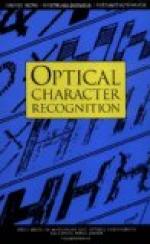|
This section contains 879 words (approx. 3 pages at 300 words per page) |

|
Optical Character Recognition (OCR) uses a device that reads pencil marks and converts them into a computer-usable form. OCR technology recognizes characters on a source document using the optical properties of the equipment and media. OCR improves the accuracy of data collection and reduces the time required by human workers to enter the data.
Although OCR is used for high-speed data entry, it did not begin with the computer industry. The beginnings of OCR can be traced back to 1809 when the first patents for devices to aid the blind were awarded. In 1912 Emmanuel Goldberg patented a machine that read characters, converted them into standard telegraph code, and then transmitted telegraphic messages over wires without human intervention. In 1914 Fournier D'Albe invented an OCR device called the optophone that produced sounds. Each sound corresponded to a specific letter or character. After learning the character equivalent for...
|
This section contains 879 words (approx. 3 pages at 300 words per page) |

|


